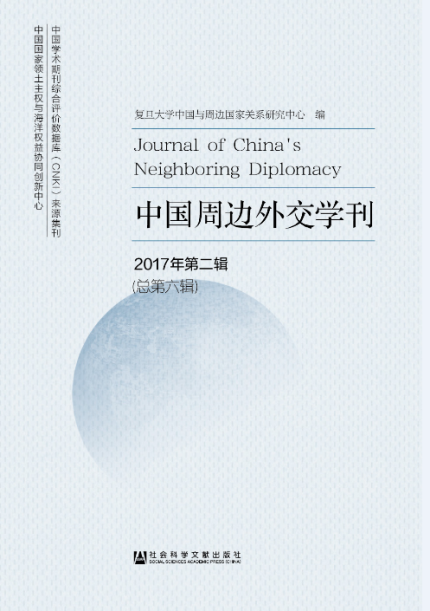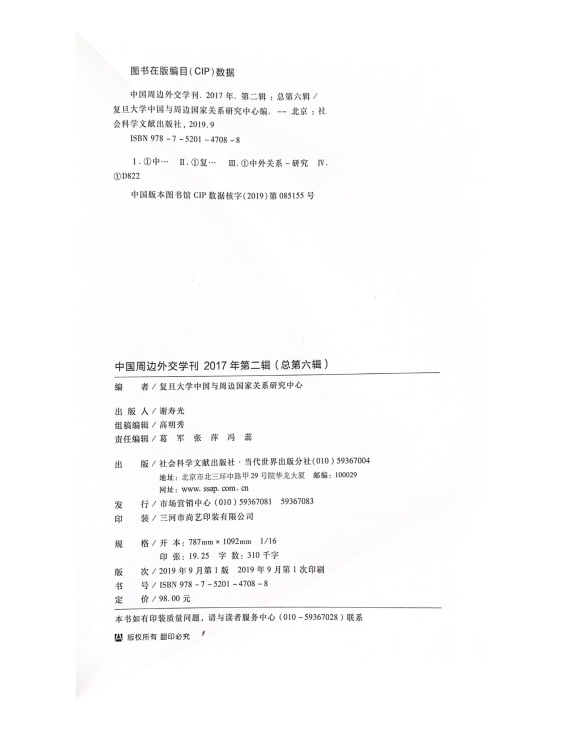Center for China’s Relations with Neighboring Countries of Fudan University (CCRNC-Fudan), ed., Journal of China’s Neighboring Diplomacy, Vol. 3, Issue 2, 2017.
Publisher: Social Sciences Academic Press (China)
Published in September 2019.
ISBN: 978-7-5201-4708-8
The Title Page of Journal of China’s Neighboring Diplomacy, Vol. 3, Issue 2, 2017 |
The Copyright Page of Journal of China’s Neighboring Diplomacy, Vol. 3, Issue 2, 2017 |
Contents
Preface
Shi Yuanhua/1
Comprehensive Studies on China’s Neighboring Diplomacy
Ideas on China’s Diplomacy with Neighboring Countries: Real Conditions and Practical Strategy
Zhou Fangyin/9
China’s Neighboring Diplomacy Strategy Guided by the Ideas of “Mutual Connectivity”
Zhao Minghao/21
The Ideas on China’s Neighboring Diplomacy during Hu Jintao’s Time
Zhong Feiteng/37
Analysis on Five Years’ Neighboring Diplomacy
Five Years’ Practice of Protecting Maritime Interests in the Seas of China’s Neighboring Areas: Practical Innovations and Experiences
Zhao Qinghai/57
Retrospect and Prospect on China’s Water Diplomacy since the 18th National Congress of Chinese Communist Party
Xiao Yang/70
The China-India Relations since the 18th National Congress of Chinese Communist Party: Development and Challenges
Lin Minwang/92
“The Belt and Road Initiative” Research
“The Belt and Road Initiative” and the Problem of World Order
Su Jingxiang/107
The Origin, Characteristics, and Realistic Value of the Ancient Northeast Asian Silk Road
Xu Bo/124
Early-Time Maritime Silk Road and the Confluence of Chinese and Indian Cultures on the Indochina Peninsula
Gu Xiaosong/140
Studies on China’s Neighboring Areas
The Northeast Asian Economic Corridor’s Promotion on China’s “the Belt and Road Initiative” Construction
Tu Bo, Zhang Yuan/157
Fishery Cooperation in the South China Sea Area and Its Influence on China’s Neighboring Diplomacy
Ren Yuanzhe, Zhang Hang/168
The Rise of China and Its Influence on the Chinese Communities in Southeast Asia: A Case Study in Indonesia
Hoon Chang Yau/183
Domestic Conditions of China’s Neighboring Countries
President Duterte’s Agenda for His Diplomacy towards China and the Future of ASEAN
Henelito A. Sevilla/203
Hot Spots in Neighboring Areas
“Power Politics” and China-U.S. Relations: A Case Study on the Korean Nuclear Issue
Fang Xiuyu/223
Chinese and Foreign Perceptions on the Legal Connotations of the “U-shape” Borderline and Several Thoughts on China’s Effort to Protect Its Interests in the South China Sea
Zhao Weihua/237
Reviews on Symposiums
A Review on the Symposium of “China’s New Concepts and New Thoughts of Neighboring Diplomacy since the 18th National Congress of Chinese Communist Party”
Xu Zhe/257
A Review on the Symposium of “The Transforming Relations between China and ASEAN: Conflict Resolution and Win-win Cooperation”
Chen Miaoling/267
A Review on the Symposium of “The Belt and Road, Neighboring Diplomacy, and Regional Cooperation in Northeastern Asia”
Qin Sheng/277
Appendix
Introduction on the Collaborative Innovation Center for Territorial Sovereignty and Maritime Rights (CICTSMR) /289
Introduction on Center for China’s Relations with Neighboring Countries (CCRNC-FUDAN) /291
Notice Inviting Contributions to the Journal of China’s Neighboring Diplomacy /293
Ideas on China’s Diplomacy with Neighboring Countries: Real Conditions and Practical Strategy
Zhou Fangyin
Abstract: Since 2013,Chinese government has proposed a series of important ideas on China's diplomacy with its neighboring countries,which contains outstanding significance and may offer long term guidance to China's neighboring diplomacy. In order to achieve certain effects,different ideas in this field have different time spans and raise different requests towards real conditions. As a matter of fact,the promotion of these ideas is also a process of competition between different ideas. Viewed from an objective perspective,the international environment seems to be disadvantageous to China's effort to promote its new ideas on neighboring diplomacy. Therefore,it is necessary for Chinese policymakers to get adapted to the changing reality,take an effort to harness current momentum and convert it into favorable trend,so as to build a micro-environment that may be beneficial to the development of those new ideas. Particularly,crisis management and control should be strengthened for the purpose of avoiding the scenario in which China's regional cooperation with its neighboring countries is largely dominated by their contradictions in security. At the same time,those new ideas themselves should be further optimized and adjusted so as to get them adapted to the reality.
Author:Zhou Fangyin,Professor and Director of Center for Studies of Neighboring Strategies at the Guangdong Institute for International Strategies,Executive Editor-in-Chief of Strategic Policymaking Studies.
Official citation: Zhou Fangyin, “Ideas on China’s Diplomacy with Neighboring Countries: Real Conditions and Practical Strategy”, Journal of China’s Neighboring Diplomacy, Vol. 3, Issue 2, 2017, pp. 9-20.
China’s Neighboring Diplomacy Strategy Guided by the Ideas of “Mutual Connectivity”
Zhao Minghao
Abstract: “Mutual connectivity” is one of the core ideas for people to understand the present reforms and future trends of China's neighboring diplomacy. In pace with the proceeding of the “Belt and Road” construction,China has strengthened its mutual connectivity with its neighboring countries in the fields of hardware,software,and humanity exchanges. Building mutual connectivity has become a major means and path for China to construct its diplomatic network and substantialize its idea of “a community of common destiny”. In brief,the concept of “mutual connectivity” is not only a policy objective,but also a new world view,a new strategic mentality,and a new paradigm for international relations. Therefore,it is necessary to take further reflections on how to elaborate and construct the “mutual connectivity theory”. In this way,the theoretical innovation on China's neighboring diplomacy can be enriched.
Author:Zhao Minghao,Ph.D.of Law,Senior Research Fellow of the Center for Contemporary World Studies at the Foreign Liaison Department of the Central Committee of Chinese Communist Party,Guest Researcher of the Collaborative Innovation Center for South China Sea Issues.
Official citation: Zhao Minghao, “China’s Neighboring Diplomacy Strategy Guided by the Ideas of ‘Mutual Connectivity’”, Journal of China’s Neighboring Diplomacy, Vol. 3, Issue 2, 2017, pp. 21-36.
The Ideas on China’s Neighboring Diplomacy during Hu Jintao’s Time
Zhong Feiteng
Abstract: During Hu Jintao's time,important progress was made in China's neighboring diplomacy,which enjoyed a degree of continuity. The guiding principle of “doing good to neighbors and regarding neighbors as partners” has been continuously practiced until present time. China is now attaching more importance to harmonious relations with neighboring countries,and the objectives of China's effort to build its relations with neighboring countries have become more and more specific and pragmatic. Furthermore,China has been increasing its investment,intensifying its operations,and strengthening its capacity for building good relations with neighboring countries,so as to share its “development dividend” with the whole neighboring area. Based on a thorough reading and analysis over Hu Jintao's speeches on foreign policy,which have been collected and compiled in ,this paper concludes that Hu Jintao has made eight major contributions in the field of China's neighboring diplomacy. In Hu Jintao's time,China's relations with neighboring countries was deepened to an unprecedented degree,as neighboring countries' economic and trade dependency on China is larger than China's dependency on them. On the other hand,neighboring areas accounted for a less share in China's overall external trade during Hu's time,so China began to examine its neighboring areas from a broader picture,so as to upgrade theoretic innovations on its diplomacy. The series of ideas about neighboring diplomacy that were proposed during Hu's time have laid solid foundations for the creation and development of new ideas,mentalities,and strategies of China's neighboring diplomacy after the 18 national congress of Chinese Communist Party.
Author:Zhong Feiteng,Ph.D.and S.J.D.,Director of division of big power relations studies in the Institute for Asia-Pacific and Global Strategic Studies,Chinese Academy of Social Sciences.
Official citation: Zhong Feiteng, “The Ideas on China’s Neighboring Diplomacy during Hu Jintao’s Time”, Journal of China’s Neighboring Diplomacy, Vol. 3, Issue 2, 2017, pp. 37-53.
Five Years’ Practice of Protecting Maritime Interests in the Seas of China’s Neighboring Areas: Practical Innovations and Experiences
Zhao Qinghai
Abstract: The unwavering attitude to protect China's national maritime interests is perhaps the most outstanding symbol of China's neighboring diplomacy in the time,which has been taking more and more initiatives. Since the 18 national congress of Chinese Communist Party,a maritime strategy for strengthening China's national capacity has been proposed and adding new connotations into its activities of protecting maritime interests. At the same time,the new ideas of big power diplomacy with Chinese characteristics also emerged,raising higher standards for China's maritime activities of protecting national interests. Under the guidance of these new ideas and perceptions,Chinese government has been continuously strengthening its executive and legislative actions to protect national maritime interests,normalizing its presence in the disputed territorial waters,and competing for an initiative through its self-organized prospecting and development. On the other hand,it has been promoting facility constructions on rocks and reefs in the South China Sea,taking an active lead in the forming of standards and rules for maritime activities,and adopting measures to handle confrontations and disputes cautiously in the field of international litigation and media. It has also managed to deal with the relations between interests-protection and stability-preservation. The successful implementation of the measures for protecting maritime interests results from an effect jointly created by the upgrading of China's overall national capacity,the close combination of top-level design and bottom-line mentality,the construction of interests-protection mechanism and system,and the proper use of various strategies and policies. A summary on these experiences will highlight the future measures that China may take to protect its maritime interests.
Author:Zhao Qinghai,Researcher and Director of the Center for Maritime Security and Cooperation at the China Institutes of International Studies (CIIS).
Official citation: Zhao Qinghai, “Five Years’ Practice of Protecting Maritime Interests in the Seas of China’s Neighboring Areas: Practical Innovations and Experiences”, Journal of China’s Neighboring Diplomacy, Vol. 3, Issue 2, 2017, pp. 57-69.
Retrospect and Prospect on China’s Water Diplomacy since the 18th National Congress of Chinese Communist Party
Xiao Yang
Abstract: Since the 18th national congress of Chinese Communist Party,the central committee of Chinese Communist Party led by XI Jinping has proposed a series of new ideas,new mentalities,and new initiatives for promoting China's neighboring diplomacy. The strategic position of neighboring diplomacy has been apparently upgraded within China's overall diplomatic arrangement. As the cross-border water resource becomes an increasingly acute and serious issue,“water diplomacy” becomes a new form of diplomacy,whose unique position and strategic significance attract more and more attentions. As part of neighboring diplomacy,water diplomacy offers an effective path for China to resolve its disputes with neighboring countries on cross-border water resource issues. Furthermore,it is also a cooperative platform for China to develop good-neighbor relations with its surrounding countries. In recent years,guided by the important idea of constructing a new type of international relations with a focus on cooperative win-win pattern,China has been exploring new practices of water diplomacy towards neighboring countries and has already made outstanding achievements. In this sense,a meticulous review and summarization of the new measures and new problems of China's water diplomacy in its neighboring areas is of great significance and may help to enrich,develop and guide the theories and practices of China's neighboring diplomacy in this new era.
Author:Xiao Yang,Ph.D.Candidate of International Law Major,Wuhan University,Research Fellow of the Collaborative Innovation Center for Territorial Sovereignty and Maritime Rights(CICTSMR).
Official citation: Xiao Yang, “Retrospect and Prospect on China’s Water Diplomacy since the 18th National Congress of Chinese Communist Party”, Journal of China’s Neighboring Diplomacy, Vol. 3, Issue 2, 2017, pp. 70-91.
The China-India Relations since the 18th National Congress of Chinese Communist Party: Development and Challenges
Lin Minwang
Abstract: Since the 18 national congress of Chinese Communist Party,China has been implementing a more active diplomacy towards India. In 2013,Chinese premier LI Keqiang chose India as the destination of his first foreign visit. Soon after Indian premier Modi took into office in May 2014,Chinese supreme leader XI Jinping also visited India and established good working relations with Modi. However,the China-India bilateral relations gradually got into a slump because of a series of structural factors of existing hostility,such as borderline confrontations,divergent perceptions on the “One Belt One Road” Initiative,and some third-party factors. This trend of slump developed into the Donglong confrontation and conflict in 2017,which was widely reported and exposed by the media. This paper aims at a systemic review and summarization on the changes and developments of China-India relations ever since China's 18 party congress in 2012.Based on this review,the author plans to reveal the inherent problems and challenges,and discuss the prospect of this unique bilateral relations.
Author:Lin Minwang,Research Fellow of the Institute of International Studies,and Deputy Director of the Center for South Asian Studies,Fudan University.
Official citation: Lin Minwang, “The China-India Relations since the 18th National Congress of Chinese Communist Party: Development and Challenges”, Journal of China’s Neighboring Diplomacy, Vol. 3, Issue 2, 2017, pp. 92-103.
“The Belt and Road Initiative” and the Problem of World Order
Su Jingxiang
Abstract: The inherent structure of the world order is incorporated and embodied the development process of human history and the overall change of the whole world. The first kind of world order in history is the compromises and confrontations between agricultural nations and nomadic peoples on the Euro-Asia Continent. Whereas the second kind of world order is the capitalism on the global scope,which was once dominated by the western Europe. The core characteristic of the current world order is the desire of the United States to pursue world dominance by employing its unprecedented military advantages. It is important to find out whether or not “The Belt and Road Initiative” may be able to create plentiful material conditions for “new and higher productive relations” within the current world order,because this prospect determines whether or not this initiative may finally change the world order.
Author:Su Jingxiang,Senior Research Fellow,the China Institutes of International Studies (CIIS).
Official citation: Su Jingxiang, “‘The Belt and Road Initiative’ and the Problem of World Order”, Journal of China’s Neighboring Diplomacy, Vol. 3, Issue 2, 2017, pp. 107-123.
The Origin, Characteristics, and Realistic Value of the Ancient Northeast Asian Silk Road
Xu Bo
Abstract: “The Belt and Road Initiative” employs the widely-accepted concept of ancient silk road to express its purpose of “bringing blessings to peoples of different countries of the world”.In this sense,it is solidly supported by historical foundations. As part of the ancient land and maritime silk road,the ancient Northeast Asian Silk Road was jointly opened and developed by various peoples living the Northeast Asian countries,so it contained a land-maritime dual nature. In the whole network of Eurasian silk roads,it enjoyed the longest history,sustained real transports of silks,and successfully integrated itself to early modern trade routes between the east and the west at the beginning of globalization age. Therefore,it has already become an important part of east-west transport routes in early modern time. In brief,the Northeast Asian region should be included into the areas covered by “the Belt and Road Initiative”. There are sufficient historical evidences that can support this claim.
Author:Xu Bo,Senior Editor and Former Editor-in-Chief of the magazine “The World Affairs”.
Official citation: Xu Bo, “The Origin, Characteristics, and Realistic Value of the Ancient Northeast Asian Silk Road”, Journal of China’s Neighboring Diplomacy, Vol. 3, Issue 2, 2017, pp. 124-139.
Early-Time Maritime Silk Road and the Confluence of Chinese and Indian Cultures on the Indochina Peninsula
Gu Xiaosong
Abstract: The maritime silk road of ancient time is both a trade route on the sea that connected China and the West Asia,and a path for cultural exchanges. The Southeast Asia is a major area of cultural confluence. In the early time,the ships sailing along the maritime silk road were usually small and weak against stormy waves,so they had to sail beside coastlines and could not afford to navigate into the distant uncharted waters of vast oceans. In this way,the Indochina Peninsula gradually became an inevitable area of economic and cultural confluence between China and India. China's material culture was disseminated westward along the seas,while India's culture was spread eastward along both land and sea routes. The exchanges and confluence of Chinese and Indian cultures not only promoted the social developments on the Indochina Peninsula,but also blended with each other. Particularly,the Cochin Area became a center for north-south exchanges of Buddhist cultures in ancient times. Viewed from a long-term historic perspective,this confluence and mutual blending was a peaceful process without serious conflicts between civilizations.
Author:Gu Xiaosong,Senior Research Fellow of the Guangxi Academy of Social Sciences,Vice President of the Chinese Association of Southeast Asian Studies,and President of the Guangxi Association of Southeast Asian Studies.
Official citation: Gu Xiaosong, “Early-Time Maritime Silk Road and the Confluence of Chinese and Indian Cultures on the Indochina Peninsula”, Journal of China’s Neighboring Diplomacy, Vol. 3, Issue 2, 2017, pp. 140-153.
The Northeast Asian Economic Corridor’s Promotion on China’s “the Belt and Road Initiative” Construction
Tu Bo, Zhang Yuan
Abstract: Based on a thorough research of current literature,this paper analyzes the forming and development of the “Northeast Asian Economic Corridor”,describes the details of its contents and characteristics,and elaborates its promotion on China's “The Belt and Road Initiative”. The Northeast Asian Economic Corridor will assist the China-Mongolia-Russia economic corridor to take a strategic extension into the Korean Peninsula and contribute to the realization of the strategic design of “The Belt and Road Initiative” in the Northeast Asia region. It will work in coordination with China's domestic plan of rejuvenating Northeast China and expand the external trade of Northeast China. In this way,it will help to reinvigorate this old industrial area of China. Also,it will help China to get involved in the peace and development process of the Korean Peninsula and bring long-term peace to this peninsula. Moreover,it will also break the U.S.-led strategic blockade circle in Northeast Asia towards China and extend China's strategic influence in this region.
Author:Tu Bo,Post-doctorate of International Studies,Research Professor,and Senior Research Fellow,East Asia University,South Korea. Zhang Yuan,Post-doctorate of the Marxism Institute of the Dalian University of Technology,Associate Professor of the Marxism Institute of the Huaihai Institute of Technology.
Official citation: Tu Bo, Zhang Yuan, “The Northeast Asian Economic Corridor’s Promotion on China’s ‘the Belt and Road Initiative’ Construction”, Journal of China’s Neighboring Diplomacy, Vol. 3, Issue 2, 2017, pp. 157-167.
Fishery Cooperation in the South China Sea Area and Its Influence on China’s Neighboring Diplomacy
Ren Yuanzhe, Zhang Hang
Abstract: Fishery cooperation is an important part of maritime cooperation in the South China Sea. In recent years,over-fishing and exacerbation of disputes on maritime legal enforcement in this region have become a serious threat to the rich fisher resources in the South China Sea region. Therefore,a series of fishery cooperation mechanisms have been established in this region. In addition,China has been operating a multiple of bilateral and multilateral fishery cooperation schemes with relevant countries in this region. In pace with the change of regional order in the South China Sea area,fishery has become an important issue that is employed by some countries to check and counterbalance China. There appear some hostile views towards China,such as “the threat of Chinese fishermen” and “the responsibility of fisher”. At present the issue of fishery has become a touchstone to test China's relations with its neighboring countries and fishery cooperation has become one of the major paths to realize the idea of a community of common destiny in China's neighboring areas. Therefore,some work is needed to be done on the perceptional transformation,practical innovation,and institutional construction,so as to achieve peace and stability in the South China Sea area through fisher cooperation.
Author:Ren Yuanzhe,S.J.D.,Associate Professor of Department of Diplomacy and Foreign Affairs Management,the China Foreign Affairs University,Senior Research Fellow of the Collaborative Innovation Center for Territorial Sovereignty and Maritime Rights. Zhang Hang,postgraduate of 2015 class,Department of Diplomacy and Foreign Affairs Management,the China Foreign Affairs University.
Official citation: Ren Yuanzhe, Zhang Hang, “Fishery Cooperation in the South China Sea Area and Its Influence on China’s Neighboring Diplomacy”, Journal of China’s Neighboring Diplomacy, Vol. 3, Issue 2, 2017, pp. 168-182.
The Rise of China and Its Influence on the Chinese Communities in Southeast Asia: A Case Study in Indonesia
Hoon Chang Yau
Abstract: The ethnic Chinese living in the Southeast Asia are leading private sectors in most member states of ASEAN. They are both investors that are important to China,and middlemen of many relevant trading activities. Due to China's continuous rise and the emerging of “One Belt One Road” initiative,the influence of Chinese communities in this region may be increased by a large margin,and the relations between these communities and China will become even closer. This paper takes a case study on the ethnic Chinese living in Indonesia,and explores the dynamic relations between China and Chinese communities in Southeast Asia. First,this paper discusses the historical traces and diversity of these communities. Second,it takes a discussion on the discriminative policy of coercive assimilation,which was enforced by former Indonesian leader Suharto,with a description on how this policy eliminated the cultural identification of ethnic Chinese. Finally,this paper takes an evaluation of the cultural politics of contemporary ethnic Chinese in Indonesia,and assess China's influence on the identify recognitions of them since the rise of China.
Author:Hoon Chang Yau,Director of Center for Advanced Studies,Associate Professor of Anthropology of the Institute of Asian Studies,University of Brunei Darussalam.
Official citation: Hoon Chang Yau, “The Rise of China and Its Influence on the Chinese Communities in Southeast Asia: A Case Study in Indonesia”, Journal of China’s Neighboring Diplomacy, Vol. 3, Issue 2, 2017, pp. 183-199.
President Duterte’s Agenda for His Diplomacy towards China and the Future of ASEAN
Henelito A. Sevilla
Abstract: Since his inauguration,President Duterte has brought outstanding changes to the foreign policy of Philippines. Particularly,there have emerged major changes on Philippines' relations with its traditional allies such as U.S. and with big countries such as China and Russia. These changes are both shaped by the personal style of leadership of Duterte himself,and closely interrelated to the domestic environment of Philippines. The domestic environment influences Duterte's perceptions and interest-related judgments,but at the same time,it limits Duterte's policy options. This paper takes an effort to understand the subtle changes of the China-Philippines relations in the past year since Duterte's inauguration. As a matter of fact,the China-Philippines is not the kind of strange relations described by the media in the west,but a kind of familiar relations in which both countries share many similarities,so they can deepen their common interests. In addition,this paper also takes an analysis over the respective domestic problems of these two countries,and observes the possible influence that Duterte's foreign policy declaration will pose on ASEAN's political and economic trends.
Author:Henelito A.Sevilla,Ph.D.,Associate Professor of Center for Asian Studies,University of the Philippines,Diliman.
Official citation: Henelito A.Sevilla, “President Duterte’s Agenda for His Diplomacy towards China and the Future of ASEAN”, Journal of China’s Neighboring Diplomacy, Vol. 3, Issue 2, 2017, pp. 203-220.
“Power Politics” and China-U.S. Relations: A Case Study on the Korean Nuclear Issue
Fang Xiuyu
Abstract: China has developed a path of socialist development with Chinese characteristics and transformed its diplomacy for several times in the past several decades. The normalization of the China-U.S. relations in 1970s was one of the several major transformations of China's diplomacy with great historical significance. In pace with the rise of China,there are more and more convergences in the interests of China and U.S.,and bilateral cooperation has been continuously deepened. However,the factors of contradictions and divergences also become increasingly outstanding. Therefore,how to reduce the frictions between China and U.S. has become an important issue in the minds of policymakers of both countries. Historical experiences reveal that an intensification of big power cooperation will not only benefit the long-term stability between big powers,but also strengthen the security and stability in regions and the whole world. Due to its geopolitical peculiarity,the Korean Peninsula is inevitably influenced by big power relations,particularly the China-U.S.relations. On the other hand,whether or not China and U.S. can handle the current tensions on the Korean Peninsula,is a delicate issue that will pose an effect on the China-U.S. relations.
Author:Fang Xiuyu,Ph.D. of Political Science,Professor and Ph.D. Tutor of the Institute of International Studies,Fudan University.
Official citation: Fang Xiuyu, “‘Power Politics’ and China-U.S. Relations: A Case Study on the Korean Nuclear Issue”, Journal of China’s Neighboring Diplomacy, Vol. 3, Issue 2, 2017, pp. 223-236.
Chinese and Foreign Perceptions on the Legal Connotations of the “U-shape” Borderline and Several Thoughts on China’s Effort to Protect Its Interests in the South China Sea
Zhao Weihua
Abstract: The legal position of “the intermittent line of South China Sea” maritime border line and territorial waters within this line has become the focus of the territorial disputes in the South China Sea. Currently,this issue is not only hotly debated by various Chinese and foreign parties for the legal connotations of this line,but also attracting a diversity of opinions and viewpoints within China. On the other hand,Chinese authority has never formally explained or elaborated the legal connotations of “the intermittent line of South China Sea” border line,which puts China into a very disadvantageous position in the international public opinions. Actually great changes have taken place in the situations around the South China Sea ever since the outcome of the South China Sea arbitrary case was declared. Particularly,China's strategy of keeping obscurity on the legal connotations of “the intermittent line of South China Sea” border line is confronted with some challenges. Under such circumstances,one of the crucial missions of China's strategy in handling its neighboring diplomacy is to work out practicable plans to handle the situational change ahead of the momentum of general trend and figure out long term strategy to keep the stability of South China Sea and protect national sovereignty and maritime interests.
Author:Zhao Weihua,Associate Professor of the Guangdong University of Foreign Studies,and Senior Research Fellow of the Guangdong Institute for International Strategies.
Official citation:Zhao Weihua, “Chinese and Foreign Perceptions on the Legal Connotations of the ‘U-shape’ Borderline and Several Thoughts on China’s Effort to Protect Its Interests in the South China Sea”, Journal of China’s Neighboring Diplomacy, Vol. 3, Issue 2, 2017, pp. 237-254.
Link to the Chinese version: http://www.iis.fudan.edu.cn/_s150/9b/cb/c11003a236491/page.psp








